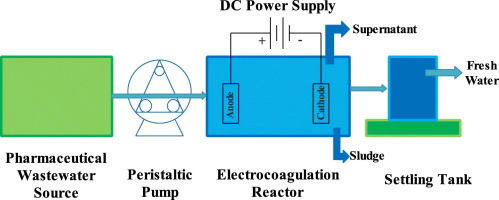Science of the Total Environment ( IF 8.2 ) Pub Date : 2020-04-06 , DOI: 10.1016/j.scitotenv.2020.138095 B K Zaied 1 , Mamunur Rashid 2 , Mohd Nasrullah 3 , A W Zularisam 1 , Deepak Pant 4 , Lakhveer Singh 5

|
The pharmaceuticals are emergent contaminants, which can create potential threats for human health and the environment. All the pharmaceutical contaminants are becoming enormous in the environment as conventional wastewater treatment cannot be effectively implemented due to toxic and intractable action of pharmaceuticals. For this reason, the existence of pharmaceutical contaminants has brought great awareness, causing significant concern on their transformation, occurrence, risk, and fate in the environments. Electrocoagulation (EC) treatment process is effectively applied for the removal of contaminants, radionuclides, pesticides, and also harmful microorganisms. During the EC process, an electric current is employed directly, and both electrodes are dissoluted partially in the reactor under the special conditions. This electrode dissolution produces the increased concentration of cation, which is finally precipitated as hydroxides and oxides. Different anode materials usage like aluminum, stainless steel, iron, etc. are found more effective in EC operation for efficient removal of pharmaceutical contaminants. Due to the simple procedure and less costly material, EC method is extensively recognized for pharmaceutical wastewater treatment over further conventional treatment methods. The EC process has more usefulness to destabilize the pharmaceutical contaminants with the neutralization of charge and after that coagulating those contaminants to produce flocs. Thus, the review places particular emphasis on the application of EC process to remove pharmaceutical contaminants. First, the operational parameters influencing EC efficiency with the electroanalysis techniques are described. Second, in this review emerging challenges, current developments and techno-economic concerns of EC are highlighted. Finally, future recommendations and prospective on EC are envisioned.
中文翻译:

通过电凝工艺去除制药废水中污染物的综合综述。
药物是新兴污染物,可能对人类健康和环境造成潜在威胁。由于药物的毒性和难处理性,无法有效地实施常规废水处理,因此所有药物污染物在环境中都变得越来越大。因此,药物污染物的存在引起了人们的极大关注,引起了人们对其在环境中的转化,发生,风险和命运的极大关注。电凝(EC)处理工艺有效地用于去除污染物,放射性核素,农药以及有害微生物。在EC过程中,直接使用电流,并且在特殊条件下,两个电极都在反应器中部分溶解。这种电极溶解会增加阳离子的浓度,最终将其沉淀为氢氧化物和氧化物。发现不同的阳极材料用法(如铝,不锈钢,铁等)在EC操作中更有效,可有效去除药物污染物。由于操作简单且材料成本较低,因此与其他常规处理方法相比,EC方法在制药废水处理方面得到了广泛认可。EC过程在电荷中和后使药物污染物不稳定,然后凝结这些污染物以产生絮凝物,具有更大的实用性。因此,审查特别强调了EC工艺去除药物污染物的应用。第一,描述了使用电分析技术影响EC效率的操作参数。其次,在这篇评论中,突出了新兴挑战,欧共体的当前发展和技术经济关注。最后,可以预见未来的建议和对EC的展望。











































 京公网安备 11010802027423号
京公网安备 11010802027423号